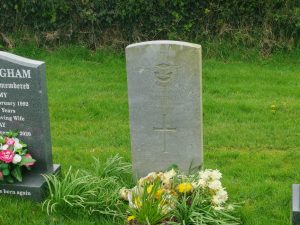Oxby, D H (Dennis Herbert)

Oxby, D H (Dennis Herbert)
Sub-Lieutenant Dennis Herbert Oxby was the son of Frederick William and Dorothy Oxby.
On the 18th of May 1971, the Sappers of the 63rd Headquarter Squadron and crew from RNAS Yeovilton had completed their task of recovering a Barracuda Mark II,[1] DP872, and its crew of three from Blackhead Moss bog, on the edge of Enagh Loch in Londonderry. It was the last known version of this plane in existence and would eventually make its way to the Fleet Air Arm Museum at Yeovilton in Somerset to be rebuilt. A watch was also found on one of the bodies, the time on it was 2:45.
Nearly 27 years previous at approximately 2:40 on the 29th of August 1944, Barracuda, DP872 was completing its take-off on runway 27 at Maydown Airfield and soon soared into the air. Shortly afterwards it was heard to have stalled then the engine started revving loudly. Witnesses realised that something was terribly wrong and watched as the plane banked to the left and plummeted to the ground, luckily missing a nearby school, but hitting some trees before it went nose first into the bog. It immediately began to slowly sink.
The crash site was soon located, and members of the Crash Crew formed at RNAS Maydown and arrived on the scene. They immediately tried to recover the bodies. The ground was treacherous, and if someone stood to long, they also would begin to sink. The men put planks down to help them get access to the cockpit. They were successful but could not open the canopy to retrieve the three airmen, so they were left to sink into their resting place, which would be the cockpit for the next 27 years.
Although the bodies were irretrievable for now, technology was not. The tail and wings contained top secret radar equipment, which was successfully detached and recovered as was part of the undercarriage which was lodged in a tree nearby and a wheel which was also detached.
The initial attempt to recover the bodies of the airmen failed. Americans also tried to help by using a pump to drain the bog. This failed also when the pump jammed. Local firemen arrived on scene but could do nothing either. It was soon decided to leave the men where they were.
During the 30th of August 1944, the site was cleaned up. The next day duct boards were laid, and an RAF Chaplin held a funeral service for the three men, Pilot, Sub Lieutenant (Air) Dennis Herbert Oxby, aged 21, from Nottinghamshire, the observer Sub Lieutenant Frederick Dobbie, also aged 21, from East Lothian, and the air gunner, Leading Airman Derek Mew, aged 19, from Norbury, London. A cross was laid later in the area to mark the spot.
All three men whose bodies were recovered were laid to rest with full military honours in Faughanvale (Saint Canice) Church of Ireland Churchyard.
Date of Death: Died 05/01/1944 (Aged 23)
Service: Sub-Lieutenant (A), H.M.S. Peewit, H.M.S. Landrail, Royal Naval Volunteer Reserve
Service Number:
Burial Location: Faughanvale (Saint Canice) Church of Ireland Churchyard, Grave 8.
[1] The Fairey Barracuda was a British carrier-borne torpedo and dive bomber. It took its first flight during 1940 and went into service during January 1943. Although 2500 were made, no complete versions of the bomber were ever kept.







